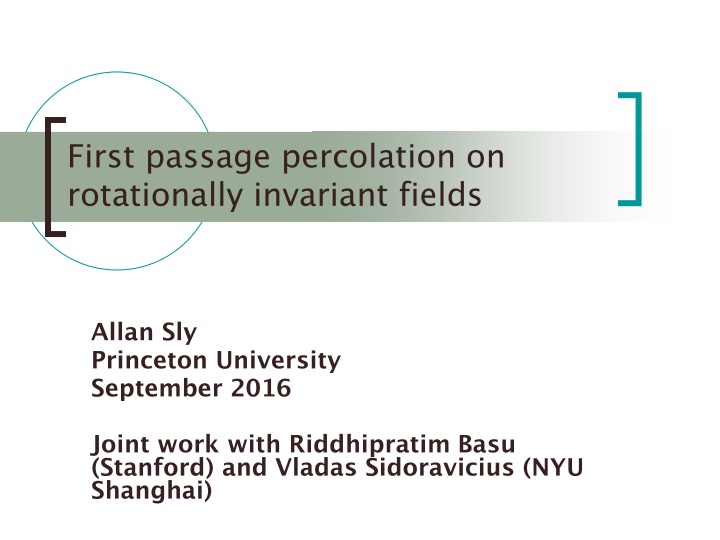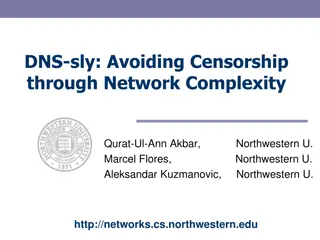
First Passage Percolation and Rotationally Invariant Models
Dive into the world of first passage percolation and rotationally invariant models, exploring concepts like variance, main results, basic approaches, and Kesten's martingale argument. Discover the interplay of random fields, path sums, and ergodic theorems in these complex systems.
Download Presentation

Please find below an Image/Link to download the presentation.
The content on the website is provided AS IS for your information and personal use only. It may not be sold, licensed, or shared on other websites without obtaining consent from the author. If you encounter any issues during the download, it is possible that the publisher has removed the file from their server.
You are allowed to download the files provided on this website for personal or commercial use, subject to the condition that they are used lawfully. All files are the property of their respective owners.
The content on the website is provided AS IS for your information and personal use only. It may not be sold, licensed, or shared on other websites without obtaining consent from the author.
E N D
Presentation Transcript
First passage percolation on rotationally invariant fields Allan Sly Princeton University September 2016 Joint work with Riddhipratim Basu (Stanford) and Vladas Sidoravicius (NYU Shanghai)
First Passage Percolation Model: ??,? an IID random field of numbers ??,? minimum sum along paths from x to y. 1 3 5 6 3 1 9 7 1 8 6 4 8 2 1 5 6 8 3 2 4 3 4 7 9 1 6 1 2 4 5 4 6 2 3 1 8 5 6 9 8 4 2 1 8 1 6 8 7 8 1 2 1 1 9 1 1 9 1 1 9 3 6 6 8 2 1 1 9 2 1 7 4 8 5 3 4 1 1 1 By Subadditive Ergodic Theorem: lim1 ??0,? ?= ?? ?.?.
Variance Central question: What is the variance? By Poincare inequality [Kesten 91] ??? ?? ?= ?(?) Using hypercontractivity for Boolean case ??? ?? ?= ?(?/log?) [Benjamini, Kalai, Schramm 03] Extended to a wider range of distributions [Damron, Hanson, Sosoe 15] For oriented last passage percolation with exponential or geometric entries ??? ?? ? ~ ? ?2/3 [Johansson 00]
Rotationally Invariant models Our model: Take : 2 2 rotationally invariant, smooth and compactly supported. Let : (?,?) be continuous and strictly increasing. Set ? ?,? ? ??(?,?) ? ?,? = Define the distance as ??,?= min ? ? ?
Main Result Main result (Basu, Sidoravicius, S. 16) For some ? > 0, ??? ??= ?(?1 ?) The specifics of the model are not that important, should hold for models with Rotational invariance FKG Property Short range of dependence. E.G. Graph distances for supercritical random geometric graphs.
Basic Approach log?? ? 2 Mutli-scale: Vn ??? ??. Set ??= = ?1 ?. ?. ? 2 We show that ??? ??? = Enough to show that for all ?, ?? ?? ??? ???=? 2 ??. Block version of Kesten s bounds ? ? ? ?? Chaos estimate path is highly sensitive to noise.
Kestens martingale argument Reveal the sites one by one: ??= ? ?? ?] Then c ??? ?? = ? ??? ?? ?? 1 ? ???? Tn | ? The value of block i will only matter if it is on the optimal path so ? ? ??? Tn | ? ?? #{? ? ?} ?? c With some extra tricks one can also get concentration bounds.
Multiscale version of Kesten argument 1/4 Split grid into blocks length ?, height Wn= ?1/2?? What we need Relate point to point with side to side Variance: ? ? ? ?? Concentration: ? ? ? ? ? ? ? ? ? ? ? ? Transversal Fluctuations of order 3/4 ?? Revealing blocks - analyze Doob martigale of ? ? ?? ?? ? ?2/3 ??
Side to side Diagonal Length 1/2 ? +1 1/2 ?2+ ??2= ?2+ ??? 2 ?? 1/2 is the bound on the standard deviation. And ??
Transversal fluctuations To move up ? blocks, extra length is 2?2 ? ? ????? ??????????? ? ? ??4/3 For other dyadic points use chaining. ??. For midpoint At least on segment must deviate from its mean by at least 1 2?2 ?? ? ??
Side to side To compare the maximum side to side length ??+ with point to point ??. Use chaining 1/2 ? ??+ ? ?? ? ??
Side to side To compare the minimum side to side length ?? with point to point ??+. Split up path 1/2 + + 2?max ? ??+ ? ?4? ?? 10,?,? + ? ?? ?? 5 Max Min Max Max
Relating mean to ? By subadditivity ? ??> ? ?. By enumerating over long paths we show that for C large if ? ?? ?? + ? ?? then lim 1 ? ? ? > ?.
Concentration ? = ? # ?????? ?? ?????? ?2 Similarly to transversal fluctuations ? > ? + ? ? ? 2/3 Apply Doob martingale and Kesten s concentration argument revealing columns one at a time. Can not take union bound over all paths because of sub- exponential tails
Proof by contradiction Case 1: Either for some 1 ? we have ? ? ? ?? in which case we show that ??? ? ? ? ?? ???. Case 2: For all ? ? ? ? ?? Use chaos argument. This case never actually happens as we believe ?? ?2/3.
Super-concentration chaos In the context of FPP: Super-concentration: Better than Poincare inequality i.e. ??= ?(?) Chaos: with ? the optimal path and ? the optimal path after resampling ? fraction of the field then ? ? ?(?) Super-concentration Chaos [e.g. Chatterjee 14 ] Works well for block version.
Proving Chaos Aim: Resample ? fraction of the blocks and find good alternatives to the original path. Need to understand the field conditioned on the path before and after resampling. Similar to [BSS 14]
Percolation type estimates We have control of the transversal fluctuations of the path. A percolation estimate says that all paths with reasonable fluctuations spend most of their time in typical regions. Atypical
FKG type estimates Conditioning on the location and value of the path is a positive event for the rest of the field. We can use FKG to sample create regions that are very positive which the optimal path must avoid (before and after resampling.
Planting a configuration For a region A, suppose that if ??,??? = (??,???) such that ? does not intersect ? then ??= ????? = ???,?] [??= ??] So we can plant configurations provided they avoid A. A
Big changes Using our assumption that ??? ? ? ? ? ? we show that we can find regions with very long and very short geodesics. By interpolation between them in 1/? steps we can find regions with a large change with positive probability after ? resampling. We look for regions which become much shorter.
Pulling the paths apart We design a collection of events which together separate the old and new paths. Positive probability at each location. Concentration estimates separate path at ? fraction of location w.h.p.
Multi-scale Improvements We look for improvements on a range of scales. Show that ? ? ?|?|. Conclude ??? ? 2 ??= ???
Lattice models Can rotational invariance be relaxed? Should be sufficient that the limiting shape is smooth and has positive curvature in a neighbourhood of the direction.




